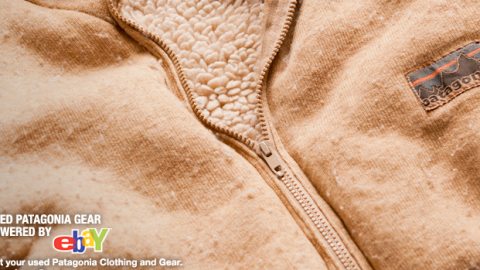Can Patagonia Convince Consumers to “Buy Less, Buy Used”?

What happens when one of America’s most successful and beloved companies suggests that consumers reduce their purchasing of new products? Outdoor outfitter Patagonia did just that – raising the economic ante for Corporate America with a first-of-its-kind “Buy Less, Buy Used” initiative, offered in coordination with eBay and the Common Threads Initiative. Instead of encouraging consumers to buy new Patagonia products on the company’s e-commerce site, the company has suggested that consumers purchase used clothing and gear via eBay auction. Not only does this represent the first time that eBay has sold items directly on another company’s e-commerce site — it represents a radical statement about the future of a U.S. economy predicated upon consumption, planned obsolescence and the relentless celebration of the new and trendy.
It’s hard to imagine other companies daring to undertake the same kind of initiative — especially within the fashion industry. Patagonia, in announcing the “Buy Less, Buy Used” initiative, explained that it was the next logical step to take in order to become a truly eco-conscious company. It also ties into the Collaborative Consumption movement, which started in earnest about a year ago with Rachel Botsman giving an inspiring speech at a TEDx event, and has been picking up momentum since then. Websites like thredUP, which encourage parents to package up used clothing that their children can no longer wear and swap it for other used clothing that their children can wear, are emerging as a result of the growth of the Collaborative Consumption movement.
Right now, we’re witnessing a hollowing-out of America’s middle class – traditionally considered the engine of economic growth in this country. Each day seems to bring further proof that more people are on food stamps, more people are slipping out of the middle class after protracted bouts of joblessness, and more people are cutting back their purchasing of expensive new items. A powerful, prosperous middle class once meant the purchasing power to buy new models of consumer goods, year after year. What happens, though, when we begin to see the erosion of the middle class, with consumers segregated into the low and high ends of the wealth spectrum? This is a phenomenon that Citigroup economists have referred to as the Consumer Hourglass Theory – and it appears to be altering the types of products that companies offer to consumers.
In a best case scenario, of course, the Patagonia-eBay arrangement to sell used goods at a lower price will eventually turn out to benefit consumers with less purchasing power. Some have even suggested that Patagonia customers off-loading their used goods on eBay will turn around and re-invest their profits in new Patagonia gear. For Yvon Chouinard, the iconic founder of Patagonia, that’s not the point, however. As the Wall Street Journal noted, he’s already made far more money than he ever intended – he’s launched the “Buy Less, Buy Used” campaign simply because it is the right thing to do to reduce the company’s environmental footprint.
Patagonia has successfully catalyzed a number of other movements in America – like making it completely acceptable to wear recycled plastic bottles as clothing. Think about that for a second the next time you see someone wearing a polarfleece jacket. (Even the new edition of the Preppy Handbook points out that it’s perfectly accceptable – even expected – that a member of the Preppy Class might wear a recycled Synchilla fleece jacket on a jaunt about town). It’s now America’s Patagonia Moment – the time to find out whether “Buying Less, Buying Used” can be made as fashionable as “Buying New, Buying Often”) once was.





